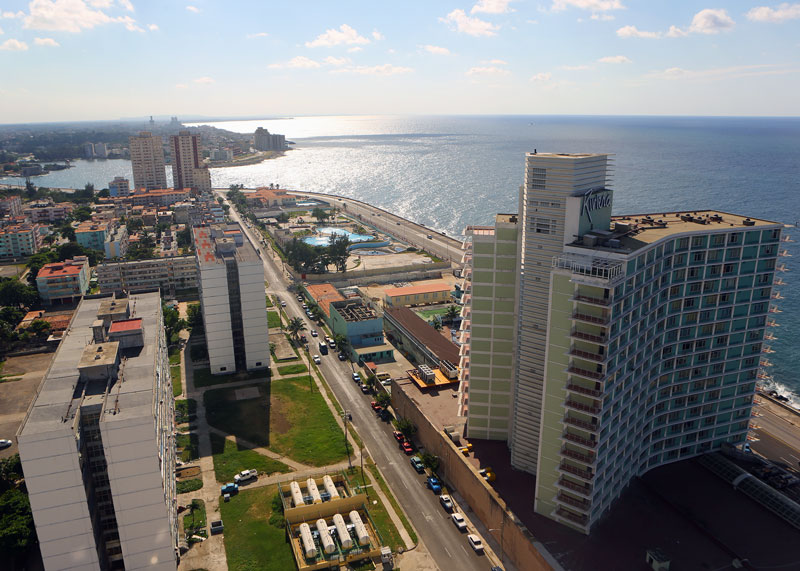
The highrise Hotel Riviera in Havana, Cuba. Photo © Christopher P. Baker.
Havana has a flavor all its own, a merging of colonialism, capitalism, and Communism into one. One of the great historical cities of the New World, Havana is a far cry from the Caribbean backwaters that call themselves capitals elsewhere in the Antilles. Havana is a city, notes architect Jorge Rigau, “upholstered in columns, cushioned by colonnaded arcades.” The buildings come in a spectacular amalgam of styles—from the academic classicism of aristocratic homes, rococo residential exteriors, Moorish interiors, and art deco and art nouveau to stunning exemplars of 1950s moderne.
At the heart of the city is enchanting Habana Vieja (Old Havana), a living museum inhabited by 60,000 people and containing perhaps the finest collection of Spanish-colonial buildings in all the Americas. Baroque churches, convents, and castles that could have been transposed from Madrid or Cádiz still reign majestically over squares embraced by the former palaces of Cuba’s ruling gentry and cobbled streets still haunted by Ernest Hemingway’s ghost. Hemingway’s house, Finca Vigía, is one of dozens of museums dedicated to the memory of great men and women. And although older monuments of politically incorrect heroes were pulled down, they were replaced by dozens of monuments to those on the correct side of history.

A concert at Basílica de San Francisco de Asís in Habana Veija. Photo © Christopher P. Baker.
The heart of Habana Vieja has been restored, and most of the important structures have been given facelifts, or better. Some have even metamorphosed into boutique hotels. Nor is there a shortage of 1950s-era modernist hotels steeped in Mafia associations. And hundreds of casas particulares provide an opportunity to live life alongside the habaneros themselves. As for food, Havana is the only place in Cuba where you can dine well every night of the week. There’s a dynamic new breed of paladar (private restaurant) owner in town and they’re now offering world-class cuisine in wow! settings. Make no bones—these are exciting times!
Then there’s the arts scene, perhaps unrivaled in Latin America. The city offers first-rate museums and galleries. Not only formal galleries, but informal ones where contemporary artists produce unique works of amazing profundity and appeal. There are tremendous crafts markets and boutique stores. Afro-Caribbean music is everywhere, quite literally on the streets. Lovers of sizzling salsa have dozens of venues from which to choose. Havana even has a hot jazz scene. Classical music and ballet are world class. And neither Las Vegas nor Rio de Janeiro can compare with Havana for sexy cabarets, with top billing now, as back in the day, being the Tropicana.
Excerpted from the Sixth Edition of Moon Cuba.